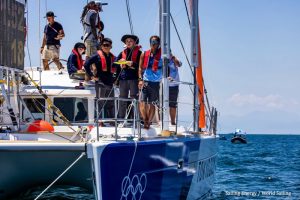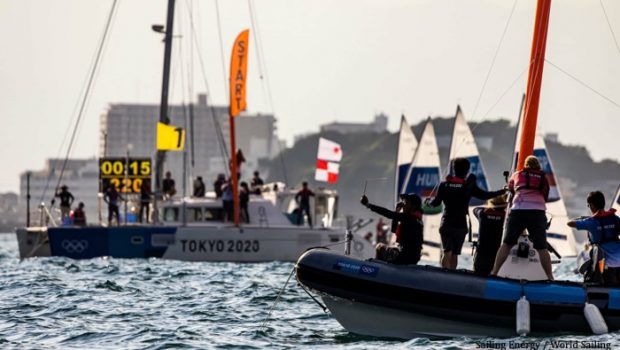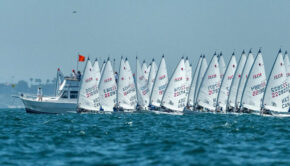Tokyo 2020: Harnessing the elements
Published on July 26th, 2021
In Athletics, in Tennis or Swimming, in pretty much any Olympic sport other than Sailing, when you show up for competition you know what the field of play is going to look like. It’s the same as the day before, and the day before that. Not in sailing. You have to expect the unexpected. Days ago, there were reports of Typhoon No.8 heading towards Tokyo, which is not uncommon around these parts with the nation well used to dealing with tropical storms.
For sailing, it is a sport that depends on the environment with athletes, racing in high-performance equipment, harnessing the power of nature. Therefore, keeping an eye on forecast is always a must. Director of Events at World Sailing and Tokyo 2020 Technical Delegate, Alastair Fox, now at his fourth Games, has seen most things in Olympic competition, “We’ve had fantastic sea breeze conditions for the last week,” says Fox.
“The typhoon was progressing up the eastern side of Japan but the forecast suggests it won’t have a major impact on Enoshima and Tokyo. Strong wind can cause some challenges for us but it’s nothing we’ve not seen before and all is ready to ensure a safe competition.”
Fox adds, “It does not look like it will bring really excessive winds. Of course, we need to keep an eye out for it. It will certainly create some challenging sailing conditions but it’s stuff that we deal with all the time, at regattas around the world. Our International Technical Officials are well used to dealing with strong wind conditions. The sailors train and prepare for extremities so it’s business as usual for us.”
There’s little that could ruffle the easy-going demeanour of Principal Race Officer Tom Duggan. He is optimistic about conditions for the Olympic Sailing Competition but is always cautious about what can follow as conditions can change rapidly. Duggan is mentally well prepared for the prospect of strong wind conditions.
“This is my sixth time here, and if I didn’t see a typhoon or strong wind conditions, it would be the first time. We’ve been here at the beginning, middle and end of them. We have a pretty good idea of what they will do or can do. We have a plan set up for small, medium, and strong winds. We know what to do.” As Principal Race Officer, Duggan’s role is to oversee all Race Management at Tokyo 2020.
There are 65 International Technical Officials in Enoshima, working alongside a team of 250 National Technical Officials, headed up by and Duggan and Deputy Principal Race Officer, Maria Torrijo. “I’m responsible for the management, care and maintenance of the six Race Management teams that operate on the water,” says Duggan.
“So my responsibility is to support and organize them and to be responsible for the sailors. You know, when they can sail, when they can’t, what time they can sail, that sort of thing.” Duggan has a lot of confidence in the local race teams.
“They are ready. The Japanese are really good. Our role is supervisory, which sometimes means it is very hands on for us if we find ourselves working with inexperienced people. But that’s not the case here; these people are really good and we’re really just showing them how the Olympic program works, to make sure that the racing goes the way the sailors are used to seeing it.”
Aside from the Race Management, there are other elements that go into creating a fair racing environment. Fox added, “We have a technical team chaired by Dimitris Dimou and Jurgen Cluytmans as the Vice Chair. At the moment they’re finishing the measurement processes for each of the events; they’re there to make sure that all the equipment is fair and class compliant so that we have a good competition on the water with no illegal or irregular equipment.
“Then we have an International Jury led by John Doerr with Andres Perez as the Vice Chair. They’re here effectively to judge on the water, in terms of Racing Rule 42 [Propulsion]. We have an umpire team within the International Jury who will be on the water for Medal Races, and the International Jury will be managing any protest that we receive as part of a normal sailing regatta back onshore after racing.”
Despite all the challenges of getting to this point, Fox was happy with the first day of racing and believes all the pieces are in place for a great event. “The venue is fantastic in terms of everything the Tokyo 2020 team have done. The equipment we’ve got is great. The branding looks good. The Japanese have done a great job. Now we’re hoping the weather will do its part.”
Tokyo 2020 details – Race information – Results – How to watch
Race schedule is staggered for the ten sailing events from July 25 to August 4.
Tokyo 2020 Olympic Sailing Program
Men’s One Person Dinghy – ILCA 7
Women’s One Person Dinghy – ILCA 6
Men’s Two Person Dinghy – 470
Women’s Two Person Dinghy – 470
Men’s Skiff – 49er
Women’s Skiff – 49erFx
Men’s One Person Dinghy Heavy – Finn
Men’s Windsurfing – RS:X
Women’s Windsurfing – RS:X
Mixed Multihull – Nacra 17
Original dates: July 24 to August 9, 2020
Revised dates: July 23 to August 8, 2021
Source: Andy Rice – World Sailing









 We’ll keep your information safe.
We’ll keep your information safe.